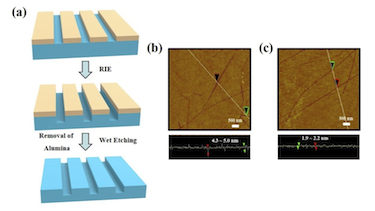Researchers at Korea University are reporting on a new way to make nano-trenches less than 5 nm deep with a technique called atomic-layer deposition (ALD), and single-walled carbon nanotubes as templates. The structures produced could be used to make high-density resistive components for a wide range of nanoelectronics devices.
Making SiO<sub>2</sub> nano-trenches
“Making nanostructures less than 5 nm in size is important for fabricating high-density nanoscale components using bottom-up techniques,” explains team leader Chang-Soo Han of the School of Mechanical Engineering at Korea University. “Our method allows us to make nano-trenches with cross-sectional dimensions (width and depth) of around 3 nm or less as well as zinc oxide nanowires with similar sizes.”
Current techniques to produce nano-trenches include photolithography, electron-beam lithography, focused ion beam milling, nano-glass blowing and nanoimprint lithography. While these approaches are able to produce very fine patterns, they are nonetheless expensive and time consuming. More importantly still, these traditional techniques are approaching their limits and generally cannot produce structures less than 5 nm in size.
Carbon nanotubes (CNTs) are sheets of carbon just one atom thick that have been rolled up into a tube with a diameter of about 1 nm. They are one of the best building blocks for making nanoscale devices thanks to their 1D structure and excellent physical, chemical, electrical and mechanical properties. Researchers have recently employed CNTs as templates to make other nanoscale architectures by filling and coating reactions. They have also been used to etch nano-trenches in SiO2.
Combining area-selective ALD with single-walled CNT masks Han and colleagues have taken such research a step forward by combining area-selective ALD with single-walled CNTs as a mask. ALD is a stepwise chemical vapour deposition technique that can be used to deposit a wide range of materials at relatively low temperatures. It is traditionally used for coating ultrathin films, but its atomic-scale thickness resolution can be exploited to create precise, ultra-small, highly uniform features on topologically complex 3D substrates.
Making metal oxide nanowires using ALD
The researchers began by depositing an ultrathin alumina layer on a SiO2/Si substrate containing SWCNTs. They then removed the SWCNTs by etching to obtain nano-trenches with an ultrasmall cross-section. They also used the same technique to deposit ZnO nanowires atop the SiO2/Si/CNTs, but in this case removed the alumina to produce ZnO structures that were about as big as the nano-trenches themselves.
Sang-Hyun Oh of the University of Minnesota-Twin Cities in the US; who was not involved in this work, says that the new technique is a "clever way of making single-digit nanometre-sized structures using selective ALD on carbon nanotube templates without using advanced lithography.
"In particular, sub-5 nm channels and nanowires can be made using this approach. While some challenges still remain such as precise control of size and shape, the resulting structures will be useful for many applications in biotechnology and optoelectronics."
According to Han, nano-trenches such as these could find use in various important applications, such as DNA separation and sieving, biosensors, gas sensors, water desalination, electronic diodes and nanofluidic transistors. “Metal oxide nanowires could also be used in ultraviolet photodetectors, nanoelectronics, photonics, nanoscale lasers and piezoelectric generators,” he tells nanotechweb.org.
The team is now busy repeating the experiments with double-walled CNTs or multiwalled CNTs that have a relatively large diameter (of 5–100 nm) to obtain thicker alumina nano-trenches.
The present work is detailed in Nanotechnology.


